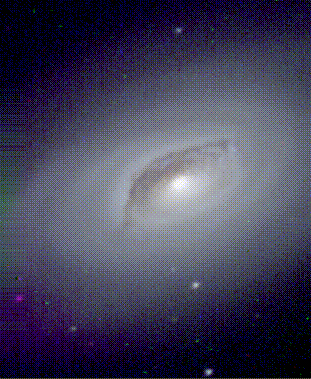

The "Black Eye" or "Sleeping Beauty" galaxy Messier 64 (NGC 4826), recently shown to have two counterrotating systems of stars and gas in its disk. The peculiar dust lane on one side of the nucleus (also a site of star formation, as shown by the blue knots imbedded in it) may be caused by material from a former companion which has been accreted but has yet to settle into the mean orbital plane of the disk. It is shown here in a log-scaled BVR composite image from the 1-meter Jacobus Kapteyn Telescope (JKT) operated by the SARA consortium on the island of La Palma.
This older (heritage?) image is a three-color composite from BVR CCD frames taken with an RCA CCD at the 1.1-meter Hall telescope of Lowell Observatory, by Bill Keel and Anatoly Zasov.

Last changes: 9/2018 © 2001-2018